#i tend to cycle through games over a period of months so i frequently return to a save with NO clue what i was doing
Explore tagged Tumblr posts
Text
more games should have a journaling function. please let me make to-do lists in stardew valley. let me keep a detailed journal of fauna behavior in subnautica. let me write silly stories about my silly slimes in slime rancher
#pleaseplrasrpleaseplraseplease#i tend to cycle through games over a period of months so i frequently return to a save with NO clue what i was doing#so a lil journal to jot down my activities in would be so nice#thank you minecraft for being the game of all time book n quill is always one my earliest items
2 notes
·
View notes
Text
Upside Down Headcanons:
Gonna tag @kingbillyharringrove because the two of us have talked in depth about this before, and @paladin-cleric-mage because they requested me to tag them! Love you guys. Lots of this will be me babbling about cool facts too because I love biology so much.
The most commonly accepted and seen headcanon- the Upside Down wildlife (with the possible exception of the Mindflayer) are a form of semi-sentient plant evolution. That being said, I'm now going to break down the different plant aspects of wildlife I have developed and would like to share, as well as habitat, time cycles, and weather.
Parasitic Plants
I would like to bring to your attention Rafflesia Arnoldii, also known as the Stinking Corpse Lily. It has a putrid, decaying flesh scent and produces the largest known individual flower in the world. "It is parasitic on members of the genus Tetrastigma (in the grape family, Vitaceae). It has no roots or leaves and most of the time lives unobserved inside the woody stems and roots of its host." (Source) Also, it looks like this:
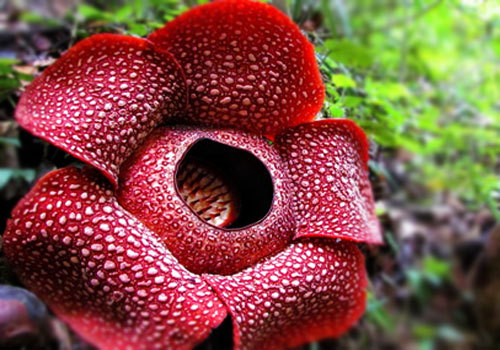
I can absolutely see the Democreatures being evolved from this beauty. In their larval stages, they would have to have a host to survive(as seen with Will, who was the host for what was probably Dart) There are many different types of Rafflesia that look very similar but are smaller however, so that's food for thought as well.
While we have not seen much in terms of the actual Upside Down (which is both a shame and a crime), it is easy to assume there are more living variants to the ecosystem than just the three we have been shown. It is, after all, an entire realm parallel to our own. And so, I would like to introduce you to Hydnora Africana, another unique parasitic plant, that grows in the roots of Euphorbia caput-medusae, a succulent. It's undetermined whether or not it has roots or a stem, though it's makeup lends it more towards having one root system and no stem. It's appearance is also fascinating, and it's far too easy to imagine some monstrous creature based off of it:


The fine white threads when in first bloom are just wide enough for beetles to get in through, but may find it difficult to escape through. After a few days the "teeth" pull apart so that the beetles may escape and distribute their pollen. (Source)
There is also the plant Orobanche fasciculata, or Clustered Broomrape. They are endangered in many states, including Indiana! (Source) "Clustered Broomrape (Orobanche fasciculata), also known as Yellow Broomrape, has mostly 5-10 long, slender, 1-flowered stalks rising from a short, trunk-like stemusually 2-6 inches (5-15 cm) long. It occurs in the midwestern and Plains states." (Source) It is also nicknamed the Cancer Root, and it's a parasitic herb. The species has both male and female reproductive organs, and is a perennial(meaning it comes back each year.) (Source) It is parasitic on the roots of Ambrosia and other members of the Compasitae. It is one of plants I have based herbivorous creatures off of, prey animals that act as a food source for Rafflesia and Hydnora variants. The reasoning for this is because of its medicinal uses. "The root is pectoral. The chewed root has been used as a dressing on wounds and open sores. An infusion of the leaves is used as a wash on sores. Forms of the plant that are parasitic on sweet sage roots have been used as a treatment of cancer." (Source) It looks like this:
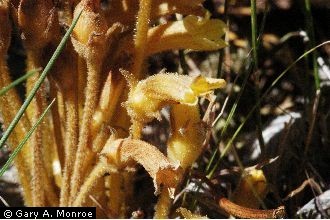
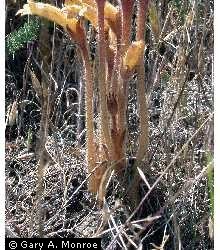
Fungi
With the spores that are constantly in the air of the Upside Down, and the often-times toxic nature of fungi, it's all too easy to picture variations of wildlife as evolved sentience from them as well. Here are some good contenders for potential wildlife!
Hydnellum Peckii, or the Bleeding Tooth Fungus, is a creature I've actually drawn and designed before! Similar to the Demogorgon, it is a humanoid omnivore. "Scientifically known as hydnellum peckii, the young bleeding tooth fungus’s thick red fluid oozes through its tiny pores, creating the appearance of blood. The underside of the cap has tooth-like spines. As it matures, the mushroom’s pale pink centre becomes dark, almost black, in colour... The bleeding tooth fungus is a mycorrhiza fungus, engaging in a symbiotic association with the roots of a vascular plant. The fungus receives fixed carbon from the host and, in return, improves the host plant’s mineral absorption." (Source) It looks like this:


The Bleeding Tooth Fungus creature is a stealth hunter, lying in wait completely still. The blood colored fluid is also scented like blood, luring in unsuspecting prey for the creature to strike quickly and effeciently. It is not built for speed but rather strength and quick movements.
Armillaria mellea, also known as a Honey Mushroom, is a parasitic version that colonizes dead or dying plants, and will kill living hosts. It has an enzyme that gives it bioluminescence, and colonized plants where this fungus is present are known as Foxfire. (Source) It looks like this:
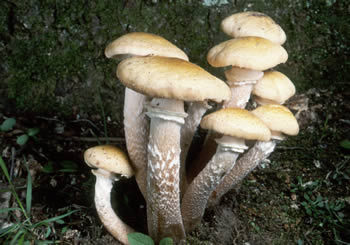
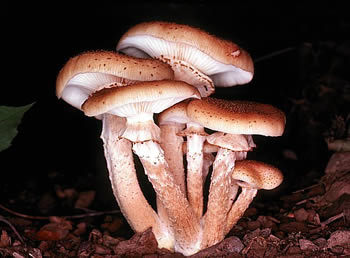
Creatures based off of these fungi would loan themselves to bioluminescence, in either a total glow or perhaps something with design, such as species patterns.
Bioluminescence
This one is purely self-indulgent and festures heavily into an AU I've had in development for months and talked about at length with @kingbillyharringrove and @wickedlittleoz for being a rare jarringrove au.
I like to headcanon that there are enzymes that exist naturally in the water of the Upside Down, and when ingested and entering the bloodstream have a reaction with white blood cells that cause a bioluminescent reaction. I like to headcanon that this is why, despite the darkness of the night, it is never truly dark. There's always a dull glow at the very least.
Day & Night Cycles
I love the idea of the Upside Down having a day time, and I now feel ROBBED knowing that the original concept art had considered it! I like the idea of the Upside Down having a Red Sun instead of a sun like ours. During the day, the world os illumimated in a reddish glow and colors appear distorted to what we are used to. The plants tend to have more bluish purple tones during the day.
The dusk and dawn times are brilliant and full of life, with all the glowing beasts and fungi bursting to life in the first hour after sunset and right before sunrise. The late night period is the darkest, when things are either sleeping or hunting. Carnivores have evolved so that their glow is hidden, patterned like the flora surrounding them. This helps hide them from prey animals who might have eyes and flee.
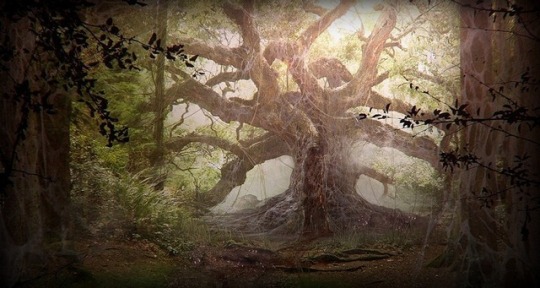
(Early concept art for the Upside Down)
Weather and Habitat
Now aside from the storm surrounding the Mindflayer, we don't have any real basis for the weather in the Upside Dowm aside from stale and still. My own headcanons include a few other phenomena including:
Acid rain storms. It's a world of death and shadows and decay. Acid rains fit in beautifully with this ideal.
Extreme heat waves, especially during the summer months when many of the creatures travel deep deep south or high high north towards the ever-frozen poles. Alternatively, the summer is when the heat-based creatures come out from hibernation or migrate back from their position at the equator.
Speaking of the equator, much like our world it's considerably warmer than the rest of the planet. Unlike our world, it's literally uninhabitable by the rest of the planet. It's a scorching barren wasteland with extreme volcanic activity and large pockets of gas below the surface of the earth that frequently boil over and explode. The gases are deadly to breathe in even for the native creatures.
Sand and glass storms. Sand storms are prevalent on the outskirts of the equator, where deserts line the center of the globe. Glass storms are closer to the center of the equator, where freak lightening and rapid heat rising keeps the sands crystalized and when the wind catches them and cools the molten sand rapidly, it turns into glass. It's not fun.
The Ocean
This one is fair game, and honestly? Not one I've put too much development into because the possibilities are wider than we can even imagine. I mean, hell. Our OWN oceans provide otherworldly horrors on a daily discovery basis. What would the Upside Down have to offer?
The only thought we've really put into it is @kingbillyharringrove and I decided that the deepest part of our own ocean was a connector to the Upside Down's. When it comes to the oceans, our worlds overlap consistently.
21 notes
·
View notes